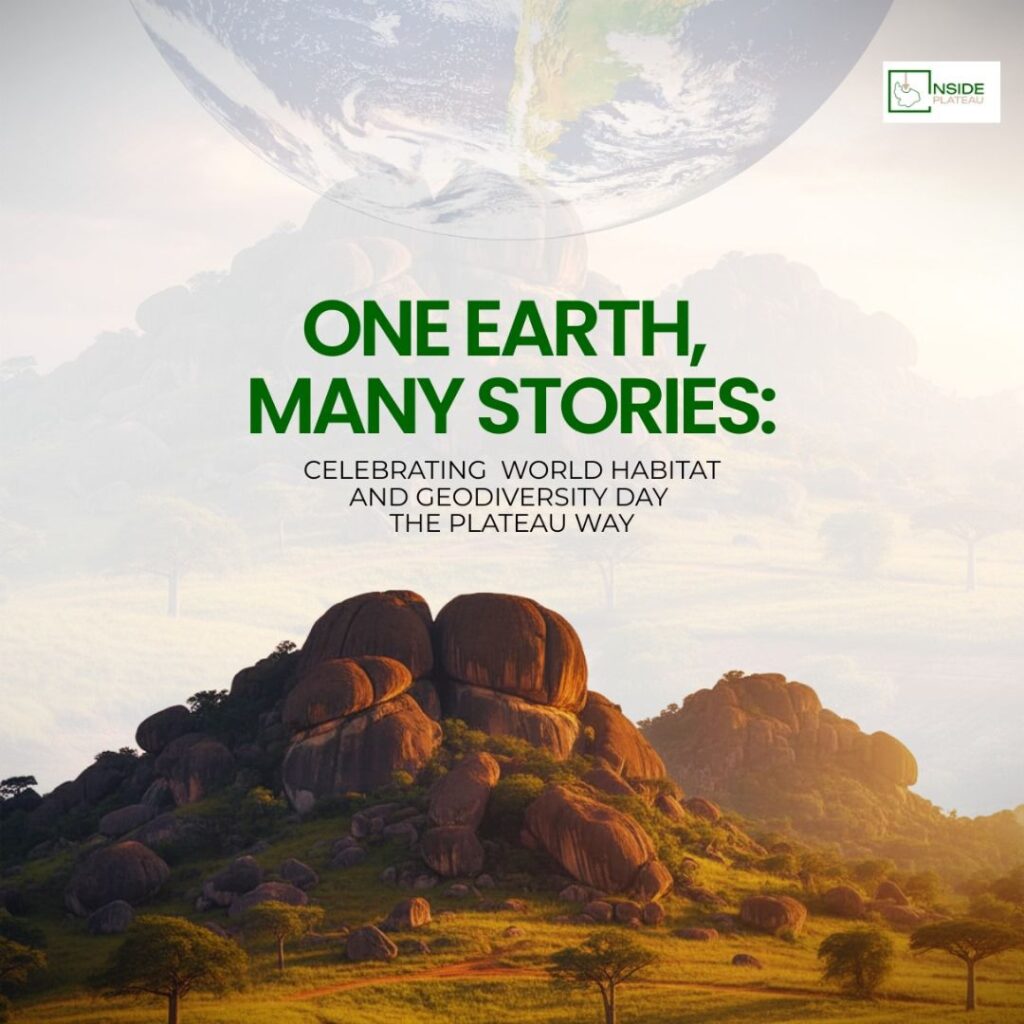Life on the Plateau
Every morning, as the sun stretches its arms across the Jos skyline, a group of schoolchildren walks past the glistening face of Lamingo Dam. Their chatter carries over the calm water, soft and clear, mixing with the hum of motorcycles, tricycles, and the numerous vehicles that speed past that same view day after day. To these children, this is just their route to school; a path as ordinary as it is beautiful. Yet, without knowing it, they are treading on a living classroom: a place where the Earth tells her story in stone, in water, and in the gentle harmony between people and nature.
For some, Lamingo Dam is a weekend retreat—a spot for picnics, fishing, the perfect selfie, or even a makeshift outdoor campsite. For others, it’s a source of livelihood as farmers draw water for their crops, some fishermen fish for daily bread, canteen owners serve steaming meals by the roadside to tourists and adventurers who crave for both culinary and visual expeditions. But for the people of Plateau, the dam is more than just scenery or resource; it is home. It’s a daily reminder of the delicate conversation between humanity and habitat, one that has unfolded for centuries across the rocks and ridges of this highland city.
What Home Means on the Plateau
And so, as the world marks World Habitat Day and International Geodiversity Day, it feels almost poetic to look toward Plateau State, a land where every valley, every stone, and every settlement embodies what these global observances stand for. And we can’t help but wonder: where better to celebrate the Earth’s many stories than on the Plateau, where nature and people have learned not just to coexist, but to thrive together?
Every year, the first Monday of October is set aside as World Habitat Day: a day when the United Nations invites the world to pause and reflect on the simple yet profound idea of home. It’s a reminder that a decent, safe, and sustainable shelter isn’t just a human right; it’s the foundation of dignity and community. It challenges cities and citizens alike to imagine better spaces; places where people and planet thrive side by side.
A few days later, on October 6, the world turns its gaze beneath the surface, marking International Geodiversity Day. This observance celebrates the varied natural features that make our planet unique (such as the rocks, soils, landscapes, and geological wonders that silently shape our lives).
This year, however, all the stars have aligned: both observances share the same date, coexisting in the same breath, reminding us that habitat and geodiversity are not separate concerns but parts of one story—the story of Earth and the life it sustains. This year’s geodiversity theme, “One Earth, Many Stories,” invites everyone to listen to the narratives written in stone and soil; the stories of how the Earth has made room for us, and how we, in turn, must make room for it.
Tradition, Modernity, and Culture
If there ever is a place where both these global stories of habitat and of Earth’s richness unfold naturally, it would be right here on the Plateau, where hills cradle homes and rivers carry livelihoods. What makes Plateau State truly remarkable is that it is not just home to those who are rooted here; instead, for generations, natives, visitors, and migrants have made this land their own. They have grown here, raised families, built businesses, and woven their lives into the very fabric of the state. Here, home is not defined by ancestry alone; it is defined by the sense of belonging, by connection, and by the rhythm of daily life in harmony with the land.
This blend of indigenous and settler populations creates a dynamic and inclusive environment where different cultures coexist, share, and learn from one another. It’s a place where diversity is celebrated, not just tolerated, and where every community, whether native or migrant, contributes to the collective story of Plateau State.
In Plateau State, the concept of home extends beyond mere shelter; it is a reflection of the diverse cultures and traditions that define the region. The state’s population of approximately 4.7 million people resides in a variety of dwellings that showcase the rich architectural heritage of its people.
Plateau Stories Written in Stone and Soil
Traditional homes in Plateau are often constructed using locally sourced materials such as mud, thatch, and stone, reflecting the resourcefulness and adaptability of the indigenous communities. These structures are designed to harmonize with the natural environment, utilizing the region’s abundant resources while minimizing environmental impact.
For instance, the Berom people are known for their distinctive round huts with conical thatched roofs, which are well-suited to the temperate climate of the Plateau. These homes are often arranged in compounds, fostering a sense of community and familial ties.
Similarly, the Ngas and Tarok communities have their unique architectural styles, incorporating elements that are both functional and symbolic, reflecting their cultural values and beliefs.
In urban areas like Jos, the capital city, modern housing developments coexist with traditional dwellings, creating a blend of old and new. Here, you’ll find a mix of residential buildings, ranging from single-family homes to multi-story apartments, accommodating the growing population and diverse lifestyles.
This architectural diversity not only provides shelter but also tells the story of Plateau’s rich cultural tapestry. Each home, whether traditional or modern, is a testament to the ingenuity and resilience of the people who call this place home.
A Home in the Sky
If Habitat Day is about people and the homes they create, then Geodiversity Day is about the land itself—the very canvas on which life unfolds. On the Plateau, the two are inseparable. Here, the hills, rocks, and rivers don’t just sit silently in the background; they interact with the people, shaping livelihoods, culture, and even the way communities see themselves.
Take Wase Rock, for instance: rising majestically from the plains near Wase town, this colossal dome is more than a geological marvel; it’s a home in the sky. For generations, it has stood watch over the land, and today, it shelters one of the rarest guests imaginable—the Great White Pelican. Yes, these graceful birds, with wingspans wide enough to stir awe in any onlooker, choose Wase Rock as one of only five breeding sites in Africa. To the local community and the government, this is sacred ground; a protected sanctuary that ensures these pelicans can thrive just as the people around them do.
Conservation and Community
Walking the Plateau, it is evident that humans and nature coexist and thrive in quiet choreography. The hills of Shere, the ridges of Jos, the flowing streams around Lamingo Dam, and the sanctuary at Wase Rock all speak the same language: “We have room for all.” It is this generosity of the land that allows species to flourish and communities to build resilient, vibrant lives.
Projects like ACReSAL at Jos Wildlife Park and the initiatives led by PEPSA and PESMDAA further illustrate this commitment. They are proof that Plateau doesn’t just celebrate its rocks and rivers in silence; it actively protects, nurtures, and sustains them. From erecting fences to safeguard wildlife, planting trees to prevent soil erosion, to creating awareness campaigns that educate both locals and visitors, the Plateau State story is one of dynamic stewardship, not passive appreciation.
And therein lies the magic: Plateau’s geodiversity is alive, participatory, and intertwined with the rhythms of human life. Whether it’s a farmer drawing water from Lamingo Dam, a family hiking up Shere Hills for the weekend, or a pelican nesting atop Wase Rock, every story reflects the harmony between people, wildlife, and the Earth.
One Earth, Many Stories, One Plateau
In this sense, the Plateau is a living illustration of this year’s Geodiversity Day theme: “One Earth, Many Stories.” Every rock, every valley, every stream carries a tale of ancient geological forces, of communities that adapted and thrived, and of ecosystems that continue to inspire awe. Here, the Earth doesn’t merely exist; it converses with its inhabitants, teaching lessons about resilience, coexistence, and the beauty of shared space.
As the sun dips behind the Jos ridges and the birds of Wase Rock settle for the night, one cannot help but feel a profound sense of gratitude for this land. Plateau State is more than just a collection of hills, rivers, homes, and tourist attractions; it is a living classroom, a sanctuary, and a stage where humanity and nature perform in harmony. Today, as we celebrate both World Habitat Day and International Geodiversity Day, the Plateau reminds us that home is more than just shelter, and the Earth is more than just soil and stone. Both are gifts to be cherished, nurtured, and shared.
From the laughter of children skipping past Lamingo Dam to the quiet vigil of pelicans atop Wase Rock, every story here testifies to the possibility of coexistence, stewardship, and resilience. Plateau State demonstrates that when communities embrace their environment and protect their geodiversity, the benefits ripple far beyond their borders, impacting livelihoods, culture, and even the next generation.

